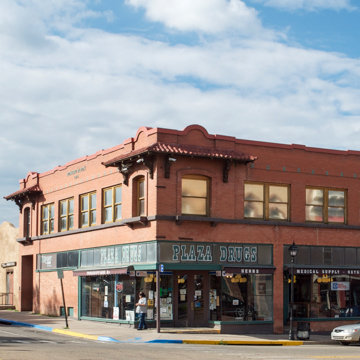You are here
Plaza Drugs
Designed by the versatile firm of Rapp and Rapp for the locally prominent Romero family, the Romero Block is an exemplary adaption of the California Mission style and the last significant commercial building to be erected on the Las Vegas Plaza.
Commissioned as a speculative endeavor by Secundino and Cleofas Romero, the Romero Block replaced a one-story adobe building that housed several earlier community drug stores, including the Romero Drug Company. The Romeros were third-generation members of one of Las Vegas’s founding families, with long-standing ties to local politics, law enforcement, mercantile development, and health care.
Their architect, Isaac Hamilton Rapp, arrived in the southwest from Carbondale, Illinois in 1888. He opened an office in Trinidad, Colorado where his brother William Morris Rapp joined him in 1892, same year they extended their practice to Las Vegas. Over the next three decades, Rapp and Rapp would design numerous Las Vegas buildings, including institutional, residential, and commercial structures.
Now best remembered as the creator of the Spanish-Pueblo, or Santa Fe Style, that he popularized in the first decades of the twentieth century, Isaac Hamilton Rapp was fluent in a wide variety of styles, from Richardsonian Romanesque, Beaux-Arts classicism, and Georgian Colonial Revival, to the California Mission style applied to the Romero Block. The style’s characteristic stepped and capped parapets, and projecting tile roofs over the corner pavilions are neatly integrated with the brick construction and large ground floor display windows of a typical commercial building.
By 1919, the Spanish-Pueblo style was emerging as New Mexico’s dominant regional image. But Rapp and Rapp had been using the Mission style since 1904, when they applied it to the New Mexico Building at the Louisiana Purchase Exposition. Closer to home, it had been adopted by the chain of Fred Harvey railroad hotels in New Mexico, including Charles Whittelsey’s Alvarado Hotel in Albuquerque (1902) and Frederic Louis Roehrig’s Casteñada Hotel in Las Vegas (1898). It is tempting to speculate that the Romeros, a proud Hispanic family of Castilian ancestry, found the California Mission style a better fit with their cultural identity than the hybrid Spanish-Pueblo style.
The Romero Block now houses Plaza Drugs and continues to operate as a community pharmacy.
References
Lopez, Jesus. “Benigno, father of the State Hospital.” Las Vegas (NM) Daily Optic, Thursday, July 17, 2014.
Lopez, Jesus. “Nuestra Historia: Eugenio, Las Gorras Blanca and the Constitution.” Las Vegas (NM) Daily Optic, Thursday, July 10, 2014.
Threinen, Ellen. Architecture and Preservation in Las Vegas: A Study of Six Districts. Las Vegas: Design Review Board, City of Las Vegas, New Mexico, 1977.
Sheppard, Carl. Creator of the Santa Fe Style: Isaac Hamilton Rapp, Architect. Albuquerque: University of New Mexico, 1988.
Wilson, Chris (with Anita Vernon and Hilario Romero). Architecture and Preservation in Las Vegas, Volume II: New Districts, New Developments. Las Vegas: Design Review Board, City of Las Vegas, New Mexico, 1982.
Wilson, Chris. The Myth of Santa Fe: Creating a Modern Regional Tradition. Albuquerque: University of New Mexico Press, 1997.
Wilson, Chris. The Plazas of New Mexico. San Antonio: Trinity University Press, 2011.
Writing Credits
If SAH Archipedia has been useful to you, please consider supporting it.
SAH Archipedia tells the story of the United States through its buildings, landscapes, and cities. This freely available resource empowers the public with authoritative knowledge that deepens their understanding and appreciation of the built environment. But the Society of Architectural Historians, which created SAH Archipedia with University of Virginia Press, needs your support to maintain the high-caliber research, writing, photography, cartography, editing, design, and programming that make SAH Archipedia a trusted online resource available to all who value the history of place, heritage tourism, and learning.

